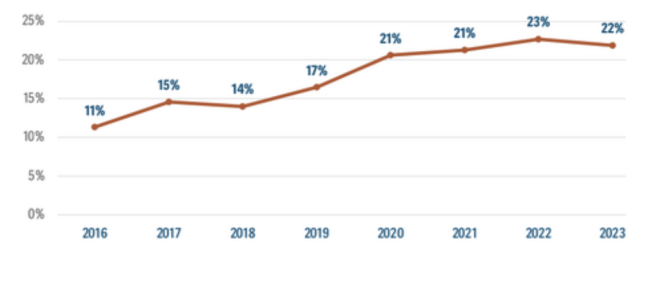
The Global Report on Food Crisis (GRFC) 2024 estimated that about 281.6 million people in 59 food crisis countries and territories faced high levels of acute food insecurity (IPC Phase 3 or above or equivalent) in 2023. This represents 21.5% of the population analysed, and is the highest number in the eight-year history of the GRFC and 9% higher than the number estimated for the year 2022.
Number of people in GRFC countries facing high levels of acute food insecurity, 2016 -2023

The trend of the total population in high levels of acute food insecurity presented by the different editions of the GRFC needs careful interpretation since the total population analysed in the report has also increased significantly over the years. When looking at the evolution of the prevalence, we observe that the proportion of people in high levels of acute food insecurity has nearly duplicated in the period 2016 – 2023. However, the report shows that the proportion has remained largely unchanged in the last four years, even with a slight decrease in the last two years.
Share of analyzed population in GRFC countries facing high levels of acute food insecurity, 2016 -2023

The GRFC identifies the drivers that have most significant impact on acute food insecurity for each country or territory. In 2023, the report considers conflict and insecurity as the major driver of food crisis one more year. Conflict and insecurity was the main driver in 20 countries and territories, where the total number of people in phase 3 or above or equivalent were 134.5 million people. Economic shocks were the primary driver in 21 countries where 75.2 million faced high levels of acute food insecurity. In addition, weather extremes were the main driver in 18 countries, with 71.9 million in high levels of acute food insecurity.
It is important to understand that food insecurity is rarely driven by a single shock or hazard, but rather by the interaction between shocks and underlying factors that make population vulnerable such as for example poverty, high exposure to natural hazards, deficient infrastructure, limited institutional capacity to support population in need and other structural weaknesses. In this regard, the GRFC 2024 has included for the first time information about structural vulnerability from different sources, including two from the JRC: the Anomaly Hot Spot for Agricultural Production and the INFORM Risk index.
More than 60 percent of the total population experiencing high levels of acute food insecurity reported by the GRFC 2024 resided in just the 10 countries listed in the graph below.
Countries with the largest number of people presenting high levels of acute food insecurity, 2023.

| Year of publication | |
| Publisher | Global Network against Food Crises (GNAFC) |
| Geographic coverage | Democratic Republic of the CongoIvory CoastPeruPalestineSenegalSierra LeonePakistanMozambiqueMyanmarNamibiaNigeriaNigerNicaraguaYemenZambiaZimbabweUgandaSudanEswatiniSri LankaSouth SudanSomaliaSyrian Arab republicTogoTanzaniaMauritaniaCentral African RepublicChadCameroonBurkina FasoBurundiDjiboutiDominican RepublicColombiaAngolaAfghanistanAlgeriaBeninBangladeshCongo [Republic]EcuadorEgyptJordanIraqLebanonMalawiMaliMadagascarLesothoLiberiaKenyaEl SalvadorEthiopiaHaitiHondurasGuatemalaGuineaGlobal |
| Originally published | 24 Apr 2024 |
| Knowledge service | Metadata | Global Food and Nutrition Security | Food security and food crises Nutrition | FamineCountries affected by conflict |
| Digital Europa Thesaurus (DET) | food aidMonitoringConflicthumanitarian aidhungerclimate changeeconomic conditionswar in Ukrainenatural disastermalnutrition |
